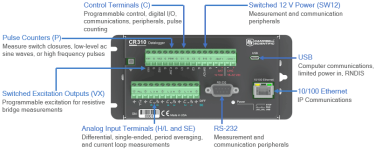Wiring panel and terminal functions
The CR300 series wiring panel provides ports and removable ![]() terminals Point at which a wire (or wires) connects to a wiring panel or connector. Wires are usually secured in terminals by screw- or lever-and-spring actuated gates with small screw- or spring-loaded clamps. for connecting sensors, power, and communications devices. It is protected against surge, over-voltage, over-current, and reverse power. The wiring panel is the interface to most data logger functions so studying it is a good way to get acquainted with the data logger. Functions of the terminals are broken down into the following categories:
terminals Point at which a wire (or wires) connects to a wiring panel or connector. Wires are usually secured in terminals by screw- or lever-and-spring actuated gates with small screw- or spring-loaded clamps. for connecting sensors, power, and communications devices. It is protected against surge, over-voltage, over-current, and reverse power. The wiring panel is the interface to most data logger functions so studying it is a good way to get acquainted with the data logger. Functions of the terminals are broken down into the following categories:
- Analog input
- Pulse counting
- Analog output
- Communications
- Digital I/O
- Power input
- Power output
- Power ground
- Signal ground
|
Analog input terminal functions |
||||||
|---|---|---|---|---|---|---|
| SE DIFF |
1 2 ┌1┐ H L |
3 4 ┌2┐ H L |
5 6 ┌3┐ H L |
|||
| Single-Ended Voltage | ✓ | ✓ | ✓ | ✓ | ✓ | ✓ |
| Differential Voltage | H | L | H | L | H | L |
| Ratiometric/Bridge | ✓ | ✓ | ✓ | ✓ | ✓ | ✓ |
| Thermocouple | ✓ | ✓ | ✓ | ✓ | ✓ | ✓ |
| Current Loop | ✓ | ✓ | ||||
|
Pulse counting terminal functions |
||||||||||
|---|---|---|---|---|---|---|---|---|---|---|
| C1 | C2 | P_SW | P_LL | SE1 | SE2 | SE3 | SE4 | SE5 | SE6 | |
| Switch-Closure | ✓ | ✓ | ✓ | |||||||
| High Frequency | ✓ | ✓ | ✓ | ✓ | ✓ | ✓ | ✓ | ✓ | ||
| Low-level AC | ✓ | |||||||||
| Quadrature | ✓ | ✓ | ✓ | ✓ | ||||||
| Period Average | ✓ | ✓ | ✓ | ✓ | ||||||
|
Analog output terminal functions |
||
|---|---|---|
| VX1 | VX2 | |
| Switched Voltage Excitation | ✓ | ✓ |
|
Voltage output terminal functions |
|||||||
|---|---|---|---|---|---|---|---|
| C1 | C2 | SE1-4 | VX1 | VX2 | P_SW |
SW12V |
|
| 3.3 VDC | ✓ | ✓ | ✓ | ✓ | |||
| 5 VDC | ✓ | ✓ | ✓ | ✓ | |||
| BAT + | ✓ | ||||||
|
Communications terminal functions |
||||
|---|---|---|---|---|
| C1 | C2 | SE1-3 | RS-232 | |
| SDI-12 | ✓ | ✓ | ||
| RS-232 | ✓ | |||
| RS-232 0-5V | ✓ | ✓ | ||
| GPS Time Sync | ✓ | ✓ | ✓ | |
| GPS NMEA Sentences | Rx | Rx | Rx | |
|
Digital I/O terminal functions |
|||||||||
|---|---|---|---|---|---|---|---|---|---|
| C1 | C2 | P_SW | SE1 | SE2 | SE3 | SE4 | SE5 | SE6 | |
| General I/O | ✓ | ✓ | ✓ | ✓ | ✓ | ✓ | ✓ | ||
| Pulse-Width Modulation Output | ✓ | ✓ | ✓ | ✓ | |||||
| Interrupt | ✓ | ✓ | ✓ | ✓ | ✓ | ||||
